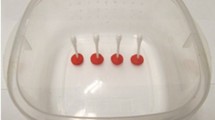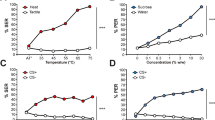Abstract.
Honey bees are ideal organisms for studying associative learning, because they can rapidly learn different sensory cues, even under laboratory conditions. Classical olfactory learning experiments have shown that the mushroom bodies (MBs), a prominent neuropil of the central nervous system of the bee, are involved in olfactory learning and memory formation. We tested whether the MBs are also involved in tactile antennal learning. As in olfactory learning, bees use the antennae during tactile learning to sense tactile cues. We produced specific MB ablations by applying the mitotic blocker hydroxyurea (HU). In Drosophila, HU-induced brain lesions of the MBs strongly impaired olfactory memory formation. As treatment with HU might also interfere with the processing of the reward stimulus, sucrose, we measured the responsiveness to sucrose stimuli in these bees. Treatment with HU led to partial ablations of the median MB sub-units on one or both sides of the brain. We analysed side-specific effects in double-blind tests, testing sucrose responsiveness separately for each antenna, and conditioning first one antenna and then the other in a reversal learning assay. HU-treated bees without detectable ablations were less responsive to sucrose and had a poorer learning performance than untreated controls. Partial MB ablation did not additionally affect responsiveness to sucrose or tactile antennal learning. Interestingly, bees with bilateral MB ablations did not differ from untreated controls in their learning performance during the first learning phase. During reversal learning, acquisition in these bees was significantly lower than that in untreated controls. It is concluded that HU treatment affects sucrose responsiveness and tactile learning even without detectable ablation of neuropils. The effects of MB ablations on tactile learning are not side-specific and not correlated with the volume of the ablated neuropil.
Similar content being viewed by others
Author information
Authors and Affiliations
Additional information
Accepted after revision: 15 January 2001
❚
Electronic Publication
Rights and permissions
About this article
Cite this article
Scheiner, R., Weiß, A., Malun, D. et al. Learning in honey bees with brain lesions: how partial mushroom-body ablations affect sucrose responsiveness and tactile antennal learning. Anim.Cogn. 3, 227–235 (2001). https://doi.org/10.1007/s100710100080
Received:
Issue Date:
DOI: https://doi.org/10.1007/s100710100080




